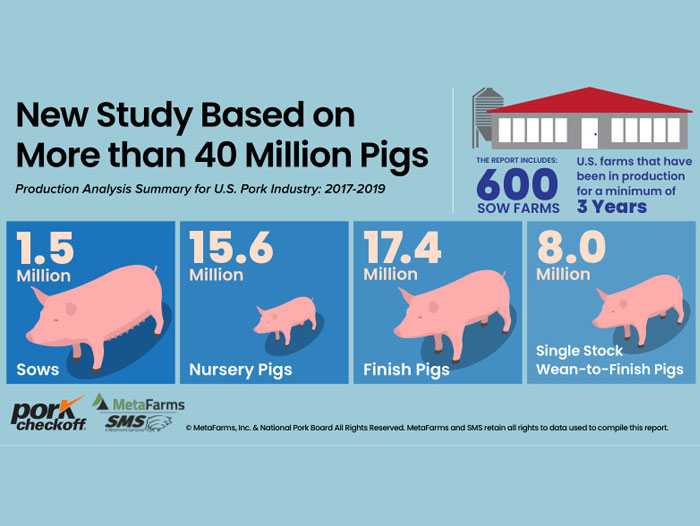New Report: Pork Industry Makes Gains in Sustainability
September 17, 2020 | 5 min to read

DES MOINES, IOWA – As America’s pig farmers continue to fight back from the negative impact of COVID-19 and the ups and downs of markets and bad weather, a new study released by the National Pork Board, Production Analysis Summary for U.S. Pork Industry: 2017-2019, shows that America’s pig farmers continue to make strides in overall sustainability by being more efficient every day.
The 15-page report, prepared by Minnesota-based MetaFarms and its subsidiary SMS (Swine Management Services), looked at sow, nursery, finish and wean-to-finish data over a three-year period. The results reconfirmed long-term trends of increasing efficiency, which has the additional benefit of reducing production costs — an especially welcome conclusion in 2020.
“One of the greatest benefits of this Pork Checkoff-funded study is the benchmarking ability it offers producers who always want to improve their efficiencies,” said Chris Hostetler, animal science director for the Pork Board. “It’s also a great way to show today’s consumers that America’s pig farms are becoming more efficient all the time and that pork is a sustainable choice when it comes to choosing a protein.”
Brad Eckberg of MetaFarms and Ron Ketchem of SMS, helped analyze much of the data in the study.
“The ability to benchmark allows producers to compare their production numbers to other farms and systems, regardless of what record program they are using, what genetics they have or their farm size,” said Ketchem, a longtime industry number cruncher. He continues to be surprised by the increasing range of production numbers between farms year after year.
“Every year, more variation occurs with new highs and lows being set,” he said. “This shows the impact in genetics and the ability of producers to manage their farms daily.”
When producers are looking at benchmarking and at ways to improve, Ketchem offers these rules of thumb:
- Farrowing rate: A 1% change in farrowing rate equals a 0.34 pig increase or decrease in pigs weaned/mated female/year. Example: A change of 4% in farrowing rate equals an increase or decrease of 1.36 pigs weaned/mated female/year.
- Piglet survival: Based on 15 total pigs born per litter, a change of 1% in piglet survival equals a 0.36 increase or decrease in pigs weaned/mated female/year. Example: A change of 4% piglet survival equals an increase or decrease of 1.44 pigs weaned/mated female/year.
- Female death loss: A 1% change in female death loss equals a 0.25 pig increase or decrease in pigs weaned/mated female/year. Example: A change of 4% in female death loss equals an increase or decrease of one pig weaned/mated female/year.
Key productivity indexes (KPIs) are used throughout the analysis of sow, nursery, finish and wean-to-finish data to draw attention to specific areas of focus within production stages. The retrospective study, the eighth of its kind funded by the Pork Checkoff since 2011, breaks the KPIs into a month-to-month format to show the effects of seasonality on the data. The findings also identify possible improvements in genetics, nutrition, health, management practices, among other areas.
According to Hostetler, the goal of the study’s production analysis is to aid the pork industry in improving profitability, which has to be part of the sustainability equation. “We hope that producers will dig into the specific parts of this study and use it to help improve their own farm businesses,” he said. “If you’re happy with your numbers in one area of production, look at another area and see where more progress can be made. It’s all about getting a little better every day.”
Study Results Based on Millions of Pigs
When it comes to the latest Production Analysis Summary for the U.S. Pork Industry, researchers compiled data from millions of pigs from all phases of production to ensure an accurate picture of the productivity of the national swine herd. Study collaborators at Swine Management Services and MetaFarms compiled data from farms across the United States that had been in production for a minimum of three years to establish multi-year comparison analysis. The 2019 dataset represents 1,588,246 sows across 600 farms, as well as 15,666,136 nursery pigs, 17,479,763 finish pigs and 8,023,610 single-stock wean-to-finish pigs.
Download a high-resolution version of the infographic here.
The National Pork Board has responsibility for Checkoff-funded research, promotion and consumer information projects and for communicating with pork producers and the public. Through a legislative national Pork Checkoff, pork producers invest $0.40 for each $100 value of hogs sold. Importers of pork products contribute a like amount, based on a formula. The Pork Checkoff funds national and state programs in advertising, consumer information, retail and foodservice marketing, export market promotion, production improvement, science and technology, swine health, pork safety and sustainability and environmental management. For information on Checkoff-funded programs, pork producers can call the Pork Checkoff Service Center at (800) 456-7675 or check the Internet at www.pork.org.
